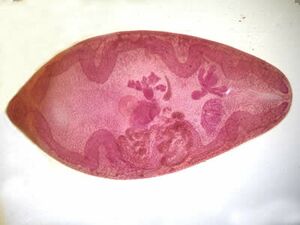Paragonimus Westermani
Classification
eukaryota; platyhelminthes; trematoda; plagiorchiida; troglotrematidae
Species
platyhelminthes paragonimus westermani
Description and Significance
Paragonimus Westermani is a part of the Paragonimus species which are hermaphroditic parasitic lung flukes. These leaf-shaped flatworms contain both male and female reproductive organs, structures, and tissues. These flukes are endemic to Southeast Asia, South America, and South Africa. They are rare in North America and Europe. These flukes infect humans who ingest undercooked crabs or crayfish that contain the Paragonimus Westermani parasite. This is significant for the southern portion of countries where crab and crayfish are endemic and have a prominent role in the food web and economy.
Genome Structure
The genome of P. Westermani is one of the largest among known pathogens with a size of 1.1 Gb. Despite the medical and economic importance of these parasites, no known genome sequence is available for any Paragonimus. A small sequence of about 84% of the total genome was able to constructed from researchers at University of Queensland. From this partial sequence, researchers discovered that Paragonimis’s genome contained around 12,852 protein coding genes, showing high similarity with related trematode species. P. Westermani’s genome has a high proportion (45%) of repeat-derived DNA. This sequence revealed a singular, high-quality circularized 20.6 kb contig. This contig consisted of a region of non-coding repetitive DNA, and three distinct repeat units. This highlights that this region is highly polymorphic and can even be used in single worm isolates.
Cell Structure, Metabolism and Life Cycle
P. Westermani are short in length and very thick. This size and shape along with their reddish-brown color give them the look of a coffee bean. They contain oral and ventral suckers as well as scale-like spines. P. Westermani has an indirect life cycle, with intermediate hosts in multiple stages of its life. First, the eggs are excreted out of the parent at which time they are un-embryonated. Once the egg is exposed to the external environment, the eggs become embryonated and hatch mature Miracidia which begin looking for their first host; which is snails since their soft tissue is easily penetrable. The Miracidia develops farther in the snail, eventually spawning many cercariae which are released from the snail. These cercariae then invade crustaceans such as crabs or crayfish, here they encyst and become metacercariae. This stage is known as the infective stage for the mammalian host. The way humans become infected is by eating undercooked crustaceans which are infected with the metacercariae of this parasite. Upon digestion the metacercariae excyst and penetrate the gut wall, where they enter the lungs, peritoneum, and diaphragm. Once these destinations are reached, they become adult. This whole cycle is fueled by the nutrients of their host and infections are known to last up to 20 years.
Ecology and Pathogenesis
Common habitats for the P. Westermani include tropical temperate bodies of water, freshwater, and temporary pools. This parasite relies on its environment to a great extent. The symbiosis relationship P. Westermani relies on exclusively is parasitism; the microbe invades its host and proliferates while harming the latter. This parasite has no geochemical or environmental impacts as everything occurs within the host. This parasite infects via animal host, when eaten undercooked. The parasite then has a human host. Paragonimiasis is the parasitic infection caused by Paragonimus Westermani. Often this infection is asymptomatic but when disease is caused, cyst formation in the lung tissue occurs. This disease is associated with other pulmonary diseases like tuberculosis due to the inflammatory response and granuloma formation. Symptoms include bronchitis, chest pain, bloody sputum, and uncontrolled coughing. Antibody tests, tissue biopsy, and egg identification in sputum are key ways of diagnosing.
References
Texeira, E., and Suárez, N. Respiratory Tract Infections: Parasites. Science Direct. 2022 https://www.sciencedirect.com/topics/medicine-and-dentistry/paragonimus-westermani#:~:text=Fourth%20Edition)%2C%202012-,Paragonimiasis,that%20contain%20the%20encysted%20parasite.
https://www.cdc.gov/parasites/paragonimus/biology.html
Fuller, D., Liere, H., Marino, J., OConnor, B., and Mulcrone, R. Paragonimus Westermani. Animal Diversity. https://animaldiversity.org/accounts/Paragonimus_westermani/
Author
Page authored by Jake Perez, student of Prof. Bradley Tolar at UNC Wilmington.

